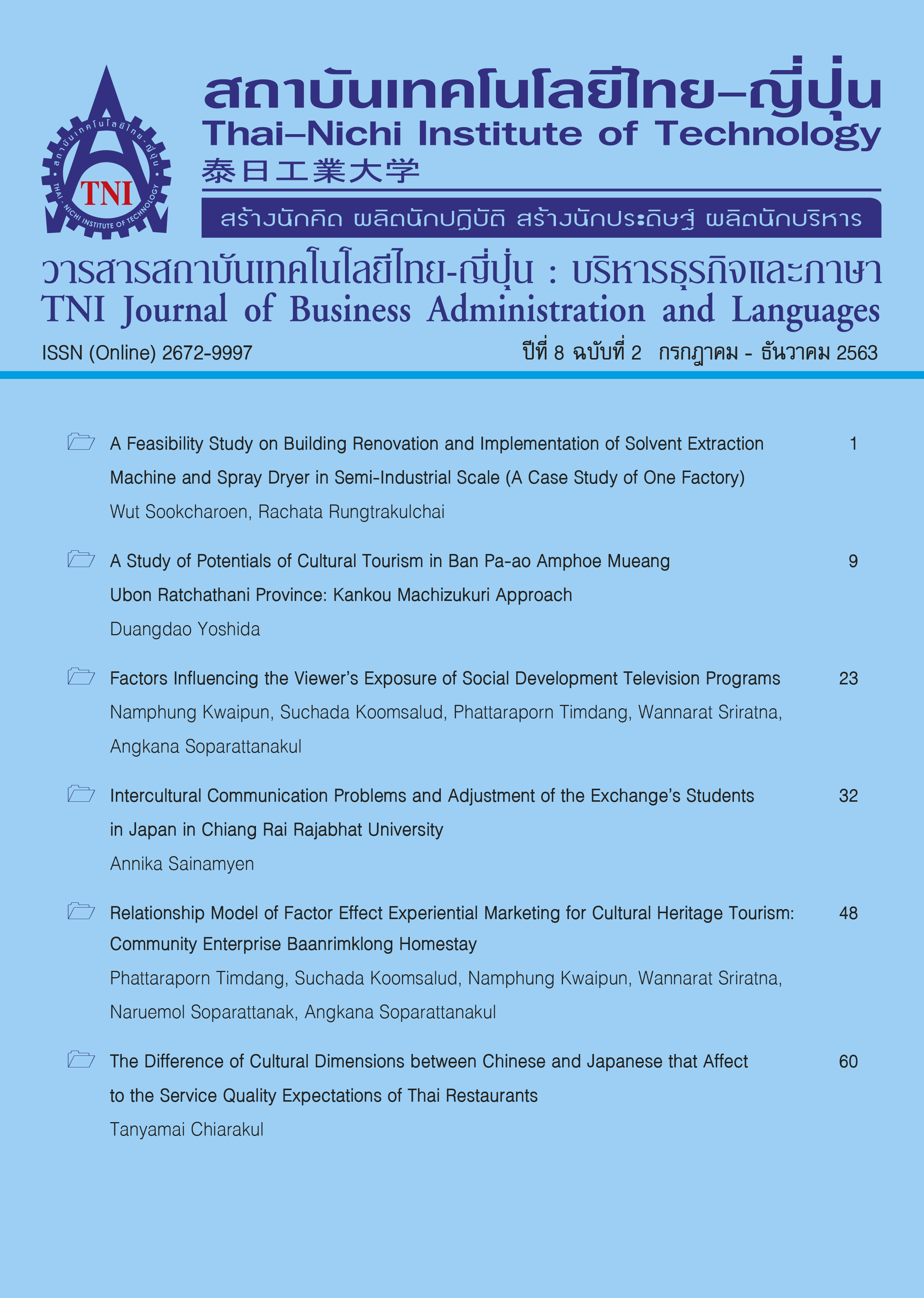The Influence of Transformational Leadership and Japanese Style Management in Operational Performance of Japanese Enterprises in the Electronic Industry
Main Article Content
Abstract
The increasingly competitive global economy pushed companies to exploit all of their available resources as a means of achieving competitive advantage. Especially the electronics industry, which has been affected by the manufacturing and export sectors, has continued to decline. The purpose of this research was to investigate and to develop the causal structural relationship model of factors influencing operational performance, to analyze and to compare direct and indirect effects of factors influencing operational performance, consisting of 3 latent variables. This research was conducted using a questionnaire as an instrument to collect data from operators 551 samples with stratified random sampling. This process was completed using the principles of structural equation modelling which required confirmatory factor analysis on the measurement model and path analysis on the structural model.
The results suggested that the theoretical model and empirical data showed a good fit χ2 =168.509, df =62, CMIN/df =2.72, Probability level (p value) =0.000, GFI =0.95 AGFI =0.93, CFI =0.98, RMR=.01, RMSEA=.05), indicating an indirect effect of transformational leadership on operational performance via Japanese style management. The effect of transformation leadership on operational performance was fully mediated by Japanese style management.
Article Details
Article Accepting Policy
The editorial board of Thai-Nichi Institute of Technology is pleased to receive articles from lecturers and experts in the fields of business administration, languages, engineering and technology written in Thai or English. The academic work submitted for publication must not be published in any other publication before and must not be under consideration of other journal submissions. Therefore, those interested in participating in the dissemination of work and knowledge can submit their article to the editorial board for further submission to the screening committee to consider publishing in the journal. The articles that can be published include solely research articles. Interested persons can prepare their articles by reviewing recommendations for article authors.
Copyright infringement is solely the responsibility of the author(s) of the article. Articles that have been published must be screened and reviewed for quality from qualified experts approved by the editorial board.
The text that appears within each article published in this research journal is a personal opinion of each author, nothing related to Thai-Nichi Institute of Technology, and other faculty members in the institution in any way. Responsibilities and accuracy for the content of each article are owned by each author. If there is any mistake, each author will be responsible for his/her own article(s).
The editorial board reserves the right not to bring any content, views or comments of articles in the Journal of Thai-Nichi Institute of Technology to publish before receiving permission from the authorized author(s) in writing. The published work is the copyright of the Journal of Thai-Nichi Institute of Technology.
References
Bass, B. M. & Avolio, B. J. (1990). The implication of transactional and transformational leadership for individual, team, and organizational development. Research in Organizational Change and Development, (4), 231-272.
Byrne, B. (2009). Structural equation modeling with AMOS: Basic concepts, applications, and programming (2nd ed.). New York: Taylor and Francis.
Catalina, G.L. (2016). Supplier quality management for component introduction automotive industry. Procedia Social and Behavioral Science, 221(1), 423-432.
DHR International Tokyo Office. (2014, November). Japan’s leadership challenges in globalization: Part 1 The race is on for Japanese global leaders. White Paper, 1-8. Retrieved from http://www.dhrinternational.com/insights/japans-leadership-challenges-globalization/
Greene, B. M. (2002). A Taxonomy of the Adoption of Lean Production Tools and Techniques. (Doctoral Dissertation). University of Tennessee, Knoxville, United Stated.
Habidin, N. F., Hashim, S., Fuzi, N. M., & Salleh, M. I. (2018). Total productive maintenance, kaizen event, and performance. International Journal of Quality & Reliability Management, 35(9), 1853-1867.
Hair, J. F., Black, W. C., Babin, B. J., Anderson, R. E., & Tatham, R. L. (2006). Multivariate Data Analysis (6th ed.). New Jersey: Prentice Hall.
Hair, J.F., Black, W.C., Babin, B.J., & Anderson, R.E. (2010). Multivariate Data Analysis (7th ed.). New Jersey: Pearson Education, Inc.
Kline, R.B. (2011). Principles and Practice of Structural Equation Modeling (3rd ed.). New York, NY: The Guilford Press.
Mahdikhani M., & Yazdani B., (2020). Transformational leadership and service quality in e-commerce business. International Journal of Law and Management, 62(1), 23-46.
Nasomboon, B. (2014). The Relationship among leadership commitment, organizational performance, and employee engagement. International Business Research, 7(9), 77-90.
Nasomboon, B., & Tuntiruttanasoontorn, B. (2018). The Japanese style of production management affecting total quality management and customer satisfaction: A case study on the best practice organization. Journal of Global Business Review, 20(1), 13-21.
Neely, A., Mills, J., Platts, K., Richards, H., Gregory, M., Bourne, M., & Kennerley, M. (2007). Performance measurement system design: Developing and testing a process-based approach. International Journal of Operations & Production Management, 20(10), 1119-1145.
Nogueira, D., Sousa P., & Moreira M. (2018). The relationship between leadership style and the success of lean management implementation. Leadership & Organization Development Journal, 39(6), 807-824.
Shrafat, F.D., & Ismail, M. (2018). Structural equation modeling of lean manufacturing practices in a developing country context. Journal of Manufacturing Technology Management, 30(1), 122-145.
Sirichai Pongwichai. (2013). Statistical data analysis with computer (in Thai). (24th ed.). Bangkok: Chulalongkorn University Press.
Suárez-Barraza, M.F., Ramis-Pujol, J. & Kerbache, L. (2011). Thoughts on kaizen and its evolution-three different perspectives and guiding principles. International Journal of Lean Six Sigma, 2(4), 288-308.
Voss, C., Tsikriktsis, N., & Frolich, M. (2002). Case research in operations management. International Journal of Operations & Production Management, 22(2), 195-219.
Womack, P.J., & Jone, T.D. (1996). Beyond Toyota: How to root out waste and pursue perfection. Harvard Business Review, 74(5), 140-158.
Worley, J.M., & Doolen, T. L. (2006). The role of communication and management support in a lean manufacturing implementation. Management Decision, 44(2), 228-245.


